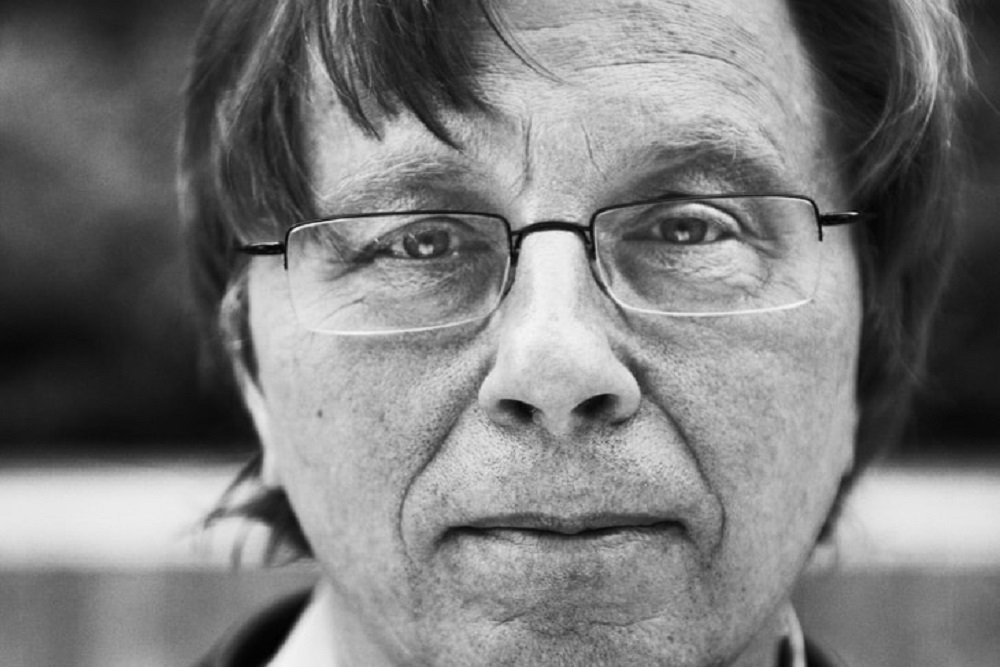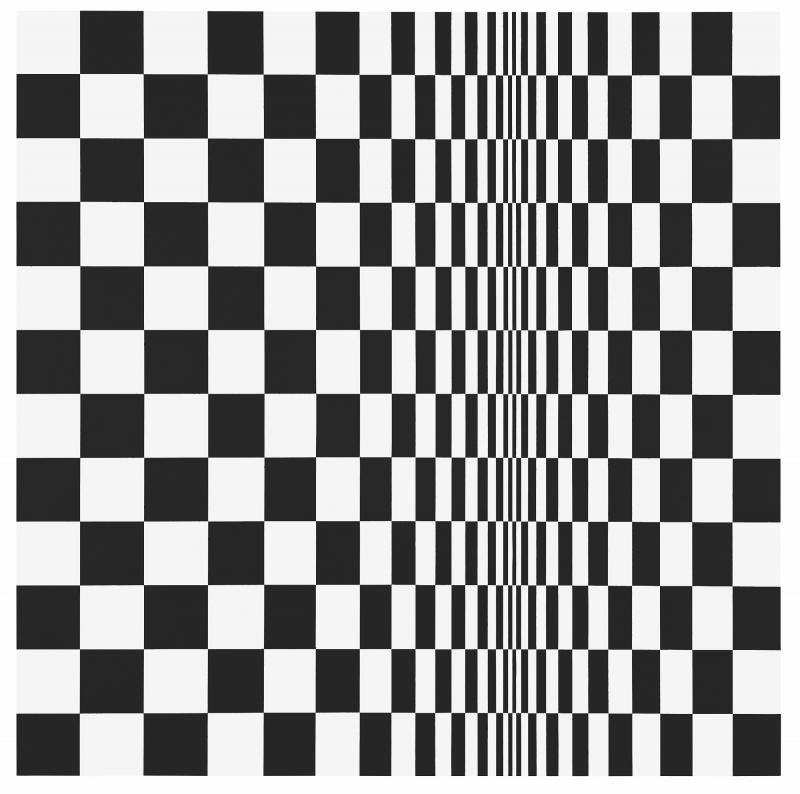Haas Hommage à Bridget Riley, London Sinfonietta, Lubman, QEH review - vibrant abstraction | reviews, news & interviews
Haas Hommage à Bridget Riley, London Sinfonietta, Lubman, QEH review - vibrant abstraction
Haas Hommage à Bridget Riley, London Sinfonietta, Lubman, QEH review - vibrant abstraction
Big commission complements a great Hayward Gallery exhibition to near-perfection

Music and visual art, at least at the highest level, should go their own separate ways; put them together, and one form will always be subordinate to the other. A composer being inspired by an artist's work, or vice versa, is something else altogether.
Any comparison will only be analogous – interestingly, Riley gives musical titles like "Paean" and "Aubade" to some of her works – but they do share much in common. In neither is the abstraction bloodless, static or merely intellectual (Riley broke the mould with what she called "conscious intuition" in the op art of the 1960s without study of optics or deeper knowledge of mathematics). Shapes shift in the vortex, surface busy-ness may yield to calms at the eye of the storm, response can be surprising – the difference between the two being that, as you spend time looking at a Riley, the point of greatest intensity can be anywhere within the experience, while in Haas' canvas the frissons are fixed in time by the composer. What Haas (pictured below by GM Castelberg) says in the short film we saw before the performance, “it seems to be repetitive, but it is not," is equally true of his music, where microtones merely increase the expressive possibilities.  And the work is full of colour, which you might paradoxically say of Riley’s earlier black and white assaults on the optic nerve. Even so, I’m not sure I would have chosen the celebrated Movement in Squares of 1961 (pictured below) as the image to show before – praise be, not during – the performance; though music evokes a different kind of “hearing picture” to any one of the canvases I’d just seen, there would have to be a wide colour palette as equivalent to the Hommage. Nevertheless, Riley’s generalisation of a parallel painting as “repose, disturbance and repose” might be turned inside out to describe Haas’s piece. It starts with buzzing strings at extremes of the register; Haas is not so cruel as to make them play constantly like this for 40 minutes, so fixed sounds emerge; piano and tuned percussion lead in evoking triads, tritones, whole-tone scales which morph very quickly into something else.
And the work is full of colour, which you might paradoxically say of Riley’s earlier black and white assaults on the optic nerve. Even so, I’m not sure I would have chosen the celebrated Movement in Squares of 1961 (pictured below) as the image to show before – praise be, not during – the performance; though music evokes a different kind of “hearing picture” to any one of the canvases I’d just seen, there would have to be a wide colour palette as equivalent to the Hommage. Nevertheless, Riley’s generalisation of a parallel painting as “repose, disturbance and repose” might be turned inside out to describe Haas’s piece. It starts with buzzing strings at extremes of the register; Haas is not so cruel as to make them play constantly like this for 40 minutes, so fixed sounds emerge; piano and tuned percussion lead in evoking triads, tritones, whole-tone scales which morph very quickly into something else.  The playing itself, like Haas’s score, was quietly miraculous in that there were hardly any jagged edges, and sequences which felt like gliding over shifting patterns in water: beautiful, limpid, evanescent. Full credit to conductor Brad Lubman, warmly applauded by the instrumentalists, for making it all seem effortless, and of course to the London Sinfonietta for commissioning the work alongside Southbank Centre and Huddersfield Contemporary Music Festival. In a generous gesture, Haas had been asked to recommend a work by a student of his at Columbia University; Katherine Balch’s New Geometry; but this was a baffling preface in which you could only sense the irregular forms, not the geometry within: remarkable, all the same, for passages on the cusp of audibility, especially in the playing of trombonist Byron Fulcher. There was also a post-interval screening of film responses to Riley and Haas from students of Central Saint Martins; but it made more sense to leave with the sensuality of the main artist and composer still resonating.
The playing itself, like Haas’s score, was quietly miraculous in that there were hardly any jagged edges, and sequences which felt like gliding over shifting patterns in water: beautiful, limpid, evanescent. Full credit to conductor Brad Lubman, warmly applauded by the instrumentalists, for making it all seem effortless, and of course to the London Sinfonietta for commissioning the work alongside Southbank Centre and Huddersfield Contemporary Music Festival. In a generous gesture, Haas had been asked to recommend a work by a student of his at Columbia University; Katherine Balch’s New Geometry; but this was a baffling preface in which you could only sense the irregular forms, not the geometry within: remarkable, all the same, for passages on the cusp of audibility, especially in the playing of trombonist Byron Fulcher. There was also a post-interval screening of film responses to Riley and Haas from students of Central Saint Martins; but it made more sense to leave with the sensuality of the main artist and composer still resonating.
rating
Explore topics
Share this article
The future of Arts Journalism
You can stop theartsdesk.com closing!
We urgently need financing to survive. Our fundraising drive has thus far raised £49,000 but we need to reach £100,000 or we will be forced to close. Please contribute here: https://gofund.me/c3f6033d
And if you can forward this information to anyone who might assist, we’d be grateful.

Subscribe to theartsdesk.com
Thank you for continuing to read our work on theartsdesk.com. For unlimited access to every article in its entirety, including our archive of more than 15,000 pieces, we're asking for £5 per month or £40 per year. We feel it's a very good deal, and hope you do too.
To take a subscription now simply click here.
And if you're looking for that extra gift for a friend or family member, why not treat them to a theartsdesk.com gift subscription?
more Classical music
 Kohout, Spence, Braun, Manchester Camerata, Huth, RNCM, Manchester review - joy, insight, imagination and unanimity
Celebration of the past with stars of the future at the Royal Northern College
Kohout, Spence, Braun, Manchester Camerata, Huth, RNCM, Manchester review - joy, insight, imagination and unanimity
Celebration of the past with stars of the future at the Royal Northern College
 Jansen, LSO, Pappano, Barbican review - profound and bracing emotional workouts
Great soloist, conductor and orchestra take Britten and Shostakovich to the edge
Jansen, LSO, Pappano, Barbican review - profound and bracing emotional workouts
Great soloist, conductor and orchestra take Britten and Shostakovich to the edge
 Jakub Hrůša and Friends in Concert, Royal Opera review - fleshcreep in two uneven halves
Bartók kept short, and a sprawling Dvořák choral ballad done as well as it could be
Jakub Hrůša and Friends in Concert, Royal Opera review - fleshcreep in two uneven halves
Bartók kept short, and a sprawling Dvořák choral ballad done as well as it could be
 Hadelich, BBC Philharmonic, Storgårds, Bridgewater Hall, Manchester review - youth, fate and pain
Prokofiev in the hands of a fine violinist has surely never sounded better
Hadelich, BBC Philharmonic, Storgårds, Bridgewater Hall, Manchester review - youth, fate and pain
Prokofiev in the hands of a fine violinist has surely never sounded better
 Monteverdi Choir, ORR, Heras-Casado, St Martin-in-the-Fields review - flames of joy and sorrow
First-rate soloists, choir and orchestra unite in a blazing Mozart Requiem
Monteverdi Choir, ORR, Heras-Casado, St Martin-in-the-Fields review - flames of joy and sorrow
First-rate soloists, choir and orchestra unite in a blazing Mozart Requiem
 Cho, LSO, Pappano, Barbican review - finely-focused stormy weather
Chameleonic Seong-Jin Cho is a match for the fine-tuning of the LSO’s Chief Conductor
Cho, LSO, Pappano, Barbican review - finely-focused stormy weather
Chameleonic Seong-Jin Cho is a match for the fine-tuning of the LSO’s Chief Conductor
 Classical CDs: Shrouds, silhouettes and superstition
Cello concertos, choral collections and a stunning tribute to a contemporary giant
Classical CDs: Shrouds, silhouettes and superstition
Cello concertos, choral collections and a stunning tribute to a contemporary giant
 Appl, Levickis, Wigmore Hall review - fun to the fore in cabaret and show songs
A relaxed evening of light-hearted fare, with the accordion offering unusual colours
Appl, Levickis, Wigmore Hall review - fun to the fore in cabaret and show songs
A relaxed evening of light-hearted fare, with the accordion offering unusual colours
 Lammermuir Festival 2025, Part 2 review - from the soaringly sublime to the zoologically ridiculous
Bigger than ever, and the quality remains astonishingly high
Lammermuir Festival 2025, Part 2 review - from the soaringly sublime to the zoologically ridiculous
Bigger than ever, and the quality remains astonishingly high
 BBC Proms: Ehnes, Sinfonia of London, Wilson review - aspects of love
Sensuous Ravel, and bittersweet Bernstein, on an amorous evening
BBC Proms: Ehnes, Sinfonia of London, Wilson review - aspects of love
Sensuous Ravel, and bittersweet Bernstein, on an amorous evening
 Presteigne Festival 2025 review - new music is centre stage in the Welsh Marches
Music by 30 living composers, with Eleanor Alberga topping the bill
Presteigne Festival 2025 review - new music is centre stage in the Welsh Marches
Music by 30 living composers, with Eleanor Alberga topping the bill
 Lammermuir Festival 2025 review - music with soul from the heart of East Lothian
Baroque splendour, and chamber-ensemble drama, amid history-haunted lands
Lammermuir Festival 2025 review - music with soul from the heart of East Lothian
Baroque splendour, and chamber-ensemble drama, amid history-haunted lands

Add comment